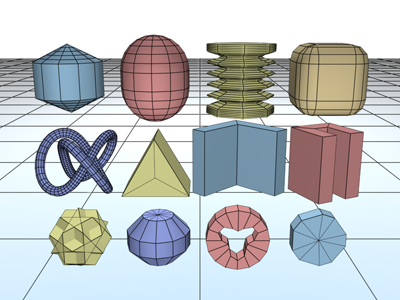Extended Primitives are a collection of complex primitives for 3ds Max. The topics that follow describe each type of extended primitive and its creation parameters.

A collection of extended primitive objects
These primitives are available from the Object Type rollout on the Create panel and from the Create menu Extended Primitives.
Extended Primitives.

All primitives offer AutoGrid. They all have name and color controls, and allow you to enter initial values from the keyboard. See these topics:
Object Name and Wireframe Color
Creating Primitives from the Keyboard (not applicable to Hedra, RingWave, or Hose)
The remaining rollouts are covered in the topic for each primitive.
Use Hedra to produce objects from several families of polyhedra.
Use Torus Knot to create a complex or knotted torus by drawing 2D curves in the normal planes around a 3D curve. The 3D curve (called the Base Curve) can be either a circle or a torus knot.
Use ChamferBox to create a box with beveled or rounded edges.
Use ChamferCyl to create a cylinder with beveled or rounded cap edges.
Use OilTank to create a cylinder with convex caps.
Use Capsule to create a cylinder with hemispherical caps.
Use the Spindle primitive to create a cylinder with conical caps.
Use L-Ext to create an extruded L-shaped object.
Use Gengon to create an extruded, regular-sided polygon with optionally filleted side edges.
Use C-Ext to create an extruded C-shaped object.
Use the RingWave object to create a ring, optionally with irregular inner and outer edges whose shapes can be animated. You can also animate the growth of the ringwave object, and you can use keyframing to animate all numeric settings. Use RingWave for various types of special-effects animation, for example, to depict the shock wave emanating from the explosion of a star or planet.
Use Prism to create a three-sided prism with independently segmented sides.
The Hose object is a flexible object that you can connect between two objects, whereupon it reacts to their movement. You can specify the overall diameter and length of the hose, the number of turns, and the diameter and shape of its "wire."